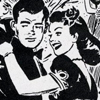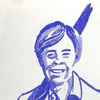“Advertising is the 'Wonder' in Wonder Bread.”
– Jef I. Richards, chair of the University of Texas-Austin Advertising Department.
![Buried, Creamated [sic] or Embalmed](strategies/25020-small.jpg)
An advertisement’s effectiveness may be evaluated by the four AIDA principles – Attention, Interest, Desire and Action. Ads must grasp the attention of an audience and be sufficiently interesting that they will be read. Successful advertisements will additionally inspire a desire or need for the product and prompt action towards its purchase. A few commercial ads are not overtly persuasional including information ads that are trying to introduce new products and services and other ads that only seek to maintain the audience’s familiarity with a brand’s well-established image.The majority of commercial ads do however attempt to prompt sales by associating brand name products with meanings that connect with the targeted audiences’ desires and beliefs.
Today just achieving the first two steps, Attention and Interest, is a challenging. Many consumers pay little attention to the promotional messages that surround them. This indifference increases the desire of advertisers to appear innovative in pitching their message. Humour, and the appeal to sexual interest, are proven attention getters.
Advertisers depend upon the research and advice of experts in sociology, social psychology, and linguistics to design persuasive appeals. Some ads still present rational arguments and factual information – i.e. prices, durability, and proven effectiveness – to make a case. However, research has demonstrated that advertising that resonates with the consumers’ psychological needs has a far better chance of inducing desired action than that which depends on the facts alone. 
An individual’s allegiance to and acceptance by social reference groups are key factors in consumer behavior. The particular groups to which one belongs or aspires can be defined by such characteristics as social or economic class, age, ethnicity or gender. Marketers seek to produce ads that speak in the language and to the experience of the reference group.
Advertising frequently plays upon anxiety or low self-esteem to suggest that the purchase of a brand product – cosmetic, clothing, car, alcohol – will enhance an individual’s prestige, physical attractiveness or sex appeal. Buying the right brands always saves thought and relieves feelings of doubt and anxiety.
Urges to social conformity are important factors in persuasion. People tend to like and listen to those who profess to like and resemble them. Many people tend to follow the lead of others in their social groups. In consequence advertisers may flatter their audiences by suggesting that they share their values, and frame their sales pitches as disinterested friendly advice. The appeal of conformity is indicated in many ad slogans or slogans such as “one million women can’t be wrong” or “the most popular brand across the nation.”
Many ads feature testimonials or paid endorsements. Personal testimonials utilize the likeability and the perceived credibility of the endorser to lead the audience to identification with the personality and acceptance of his or her opinions. Endorsements by entertainment and sports celebrities may encourage the fantasy that some of the star’s persona will rub off if they use the same product.
 Deference to experts and recognized authority figures such as doctors, scientists, policemen and military leaders, is employed in many advertisements. It is not always evident how the figure’s expertise relates to the qualities of the advertised product. Deference to experts and recognized authority figures such as doctors, scientists, policemen and military leaders, is employed in many advertisements. It is not always evident how the figure’s expertise relates to the qualities of the advertised product.
Nostalgic sentiment underlies the identification of some brands with the past, usually presented as a time of greater innocence and certainty. Nostalgia has a certain appeal in times of rapid change, but as one critic notes, teenage girls have no interest in using the cosmetic brands of their grandmothers. The flip side of nostalgia is the promotion of products emphasizing their novelty, their modernity or position on the cutting edge.
 Emotions such as fear, hatred and distrust are utilized in negative advertising. The direct slagging of one’s competitor is relatively uncommon in commercial advertising but is synonymous with wartime propaganda and ubiquitous in modern political campaigns. Many posters were produced by Canadian military authorities in both World Wars. Though a few exploited fear in demonizing enemy leaders and soldiers, most Canadian posters simply ridiculed the enemy. More common were posters evoking the heroism and achievements of Canadians, both on the war and home fronts. Emotions such as fear, hatred and distrust are utilized in negative advertising. The direct slagging of one’s competitor is relatively uncommon in commercial advertising but is synonymous with wartime propaganda and ubiquitous in modern political campaigns. Many posters were produced by Canadian military authorities in both World Wars. Though a few exploited fear in demonizing enemy leaders and soldiers, most Canadian posters simply ridiculed the enemy. More common were posters evoking the heroism and achievements of Canadians, both on the war and home fronts.
Negative attack ads have portrayed Canadian politicians as corrupt, incompetent, mean-hearted, bigoted, anti-family, anti-West, anti-French, fascist, communist and dithering. Canadians’ appetite for such ads, and their effectiveness in political campaigns, has been much debated.
|






